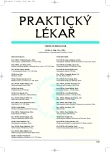Physical activity and obesity.
Authors:
J. Pařízková
Authors‘ workplace:
Endokrinologický ústav, Praha
; Ředitel: doc. MUDr. Vojtěch Hainer, CSc.
; Centrum pro diagnostiku a léčbu obezity
Published in:
Prakt. Lék. 2007; 87(3): 189-192
Category:
Therapy
Overview
Reduction of energy output due to lowered physical activity is considered as one of the most important factors in the development of obesity, especially during childhood. Questionnaires, pedometers, sports testers (which register pulse frequency), or doubly labelled water (D2 18O) method are used to assess physical activity and energy output. The WHO guidelines use the daily registration of individual activities characterized by multiples of basal metabolic rate (BMI, MET). Dynamic, aerobic physical activity (walking, running, cycling etc.) is most suitable for weight reduction since it increases cardiorespiratory efficiency and improves the transfer of oxygen to skeletal muscles, which is the condition for the utilization of fat as an energy source. Reduction of serum lipid level, blood pressure, improvement of insulin resistance and glucose tolerance, and the limitation of orthopedic and psychological problems was also found after the reduction of weight by increased activity. To preserve the desirable weight, an energy output of cca 12 kcal/kg body weight/day, or at least 10 000 paces/day is recommended. To prevent obesity, 40–60 min of mild activity/ day is recommended, and 60–90 min/day is thought to prevent repeated increase of body weight in previously obese individuals.
Key words:
Physical activity, evaluation, obesity, comorbidities.
Labels
General practitioner for children and adolescents General practitioner for adultsArticle was published in
General Practitioner

2007 Issue 3
Most read in this issue
- Testosterone replacement therapy in aging men.
- Drug-induced gynecomastia
- ACTH-dependent Cushing’s syndrome due to a carcinoid tumour Cushing’s
- Thyroid cancer and malignant lymphoma – is there a relationship?
